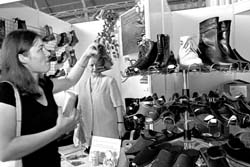92 % of Ukrainian light industry goods are sold in the West

You need not indulge in any painstaking study of the average Ukrainian’s basket of goods to realize that the comparison of the number of people wearing and eating domestically-made products and foreign-made ones is far from favoring Ukrainian light industry. Simultaneously, consumers are unanimous saying that Ukrainian-made clothes can be both of high quality and fashionable. The reason for low sales is quite different: where is one to get the money from to buy domestically made goods? For example, a Turkish T-shirt will cost half as much, and you do not have to visit half a hundred of stores to buy it. That is why the balance in favor of buying Ukrainian goods can be tipped only by one’s patriotic feelings.
To date, there are 9000 enterprises in the light industry sector, with 4000 of them making clothes. But no one says that their number is quite sufficient for a country of 49 million. Incidentally, Soviet experts calculated that an individual needed four pairs of shoes, twenty-three square meters of fabric, and seven items of clothing made from this fabric a year. At present, however, there is one pair of domestically-made shoes for every ten children.
The reason for this is that almost all light industry enterprises operate on a swap pattern, supposedly, their directors maintain, to avoid downsizing of staff and retain professional skills of workers. On the other hand, Europe gives Ukrainian light industry companies everything they need for their work, including equipment and inputs in exchange for cheap footwear and clothes. Ukrainian companies’ staff agree to being called cheap labor, arguing that, otherwise, they would be out of work. A mere 8% of domestically-made goods are sold on Ukrainian markets, with 92% finding its way to the suppliers of equipment and inputs. But for directors, the swap pattern has other brighter sides. First, it has become by no means a bad school for domestic designers, and seeing the latest fashion trends and catering for consumers’ needs, they create quite stylish finery. Second, lacking modern equipment from the West, Ukrainian light industry would have simply gone under.
The going is especially tough for larger enterprises as taxes and fluctuating electricity rates are completely eating up their profits. According to the Horlivchanka Company Director Svitlana Bohdaniuk, her firm is faced with an acute shortage of staff, with workers who monthly receive 200 hryvnias (about $37) agreeing to stay on their jobs for no more than three months. Instead, they prefer to go on welfare and moonlight in bootleg haberdasheries.
The latter either do not pay taxes at all, or by cooking their books pay a mere fraction of what is due. Such machinations make it possible for them to set prices on their goods much lower than the one set by their legal business rivals.
Creeping privatization and the fragmentation of larger enterprises (although from the technological point of view this is not good for business) is a shot in light industry’s arm. But it is quite difficult to stay competitive even for small businesses, and not necessarily due to lower quality. According to Ukrlehprom (Ukrainian Light Industry) Executive Director Tamara Kyrychenko, there are UAH 4 billion worth of bootleg consumer goods on the Ukrainian market now, either made illegally here or contraband imports. By not paying taxes, the lords of the shadow economy can easily squeeze legally operating companies out of their markets by making them lose money on domestic sales.
With this in view, on September 4 the Association of Light Industry Enterprises signed a joint memorandum with the government on priority measures to save domestic light industry, notably, enacting tougher laws on the origin and quality of goods. Several directors offer their own proposals on how to deal with the issue, suggesting higher customs duties on clothes and footwear or substantially curbing their import. Ukrlehprom opts for fair competition, saying all manufacturers should work on equal footing. What we have in Ukraine now is a paradoxical situation when light industry reportedly growing by 150% annually and domestically- made goods for Ukrainians are a rarity.






